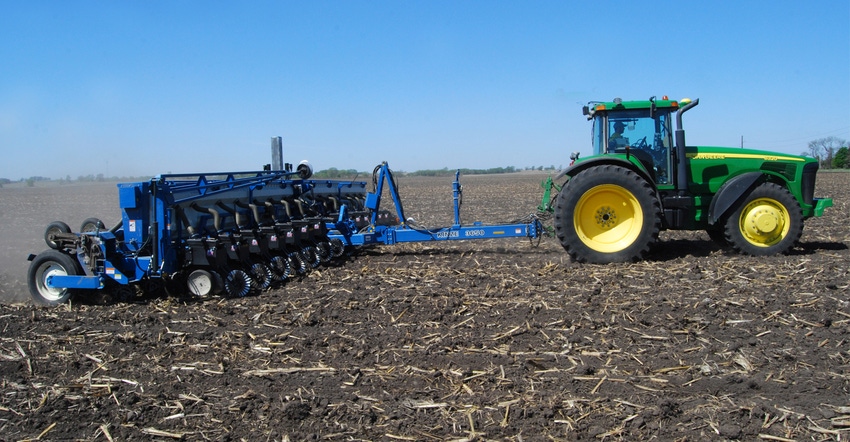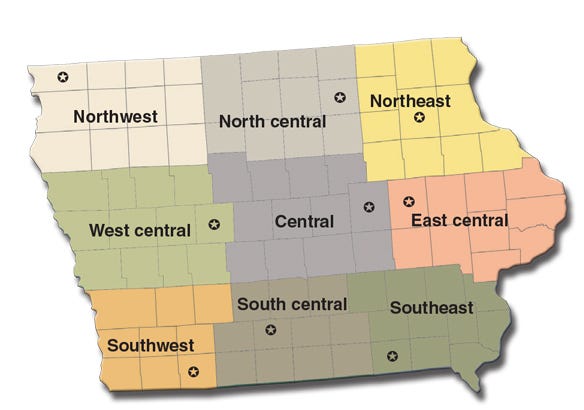April 10, 2019

The arrival of spring fieldwork and planting marks the beginning of another farmland sales season. It seems the land market across Iowa sets a slightly new course each year, based on progress in the fields.
When planting and growing conditions are favorable, crop prospects are high and optimism is easier to find. Because the farmland market is impacted by the confidence of its participants, land prices tend to be stable to higher when things are going well. However, the market can also become a bit shaky when things are not working quite as smoothly.
Moving into spring 2019, the Iowa farmland market is showing continued resilience and stability. Value differences still exist from neighborhood to neighborhood. Local growing conditions and sale volumes influence the underlying value differences across the region.
Regardless of where you are, high-quality farms with above-average soil types, adequate to good drainage, easy farm-ability and well-managed fertility continue to sell best. Farmers are still buying nearly 8 of every 10 farms offered on the market, although nonfarming investors remain an influential buying segment in most corners of Iowa.
As always, many factors are influencing current land sales and values. First, the success (or struggle) of the growing season will play an important role in current and upcoming land sales.
Next, keep an eye on the level and direction of interest rates. The current interest rate environment is a somewhat curious one. For over two years, the Federal Reserve has been inching short-term rates higher — a policy that in late 2018 was also beginning to have an impact on long-term rates. However, U.S. and global economic growth started to wane in early 2019, and the Fed has outwardly signaled no rate increases for the remainder of 2019.
This adjustment has impacted the bond markets, and long-term rates have fallen the past 60 days, relative to short-term rates. In fact, long-term rates have fallen to the point where the yield curve has inverted (e.g., long-term rates lower than short-term rates). Unfortunately, an inversion of the yield-curve has in the past been a relatively strong indicator of forthcoming economic recession. So, where rates move for the remainder of 2019 will be worth watching.
Commodity markets are a major influencer in actual farm profitability, as well as the collective confidence and psyche of the Midwest land market. And the mood has not been very positive lately. Enormous early-season expectations for 2019 corn acreage, as well as huge ending stocks for soybeans, have both been pressuring the corn and soybean markets. Hope remains for positive news on global trade negotiations, particularly with China.
And for better or worse, the outcome of trade negotiations will continue to impact commodity prices and underlying asset values, including farmland. Further into the growing season, keep an eye on both the level and direction of commodity prices. Other market-driving factors are sure to emerge in mid-2019, so stay tuned for further analysis as new information surfaces on these and other topics.

NORTHWEST
Lyon County. Northeast of Larchwood, 105 acres sold at public auction for $11,000 per acre. The farm consists of 99 tillable acres with a 67.9 CSR2, which equals $171 per CSR2 point on the tillable acres. The farm has an electric line and power poles running through the middle of the property.
NORTH CENTRAL
Floyd County. Near Powersville, 78 acres sold at public auction for $4,500 per acre. The farm consists of 77 tillable acres with a 72.1 CSR2, which equals $63 per CSR2 point on the tillable acres.
NORTHEAST
Fayette County. Southeast of Fayette, 100 acres sold at public auction for $7,700 each. The farm has 100 tillable acres with an 85.6 CSR2, which equals $90 per CSR2 point on the tillable acres.
WEST CENTRAL
Greene County. South of Scranton, 40 acres sold at public auction for $8,600 per acre. The farm consists of 38 tillable acres with an 84.8 CSR2, equaling $106 per CSR2 point on the tillable acres.
CENTRAL
Tama County. West of Lincoln, 160 acres sold at public auction for $12,700 per acre. The farm consists of 158 tillable acres with a 91.6 CSR2, which equals $140 per CSR2 point on the tillable acres.
EAST CENTRAL
Benton County. Northwest of Walford, 215 acres sold for $11,000 per acre. The farm consists of 214 tillable acres with an 89.2 CSR2, or $124 per CSR2 point on the tillable acres.
SOUTHWEST
Taylor County. North of Bedford, 37 acres sold at public auction for $3,600 per acre. The farm consists of 33 tillable acres with a 51.9 CSR2, which equals $78 per CSR2 point on the tillable acres.
SOUTH CENTRAL
Madison County. Northwest of Lorimor, 117 acres sold for $6,100 per acre. The farm has 109 tillable acres with a 68.3 CSR2, or $96 per CSR2 point on the tillable acres.
SOUTHEAST
Davis County. West of Bloomfield, 215 acres sold at public auction for $2,750 per acre. The farm consists of 163 tillable acres with a 39.2 CSR2, which equals $92 per CSR2 point on the tillable acres. The land is being used for pasture. The sale also includes a cattle barn and silo.
Hertz Real Estate Services compiled this list, but not all sales were handled by Hertz. Call Hertz at 515-382-1500 or 800-593-5263 or visit hertz.ag.
You May Also Like




